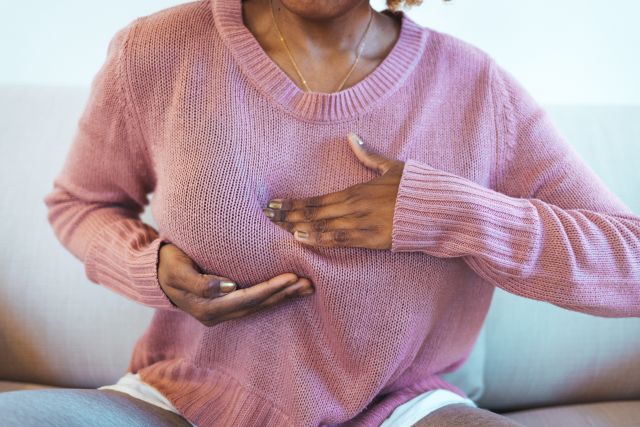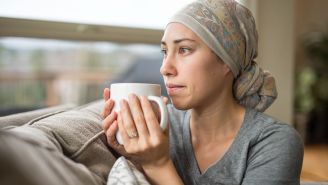Updated on May 31, 2024.
Breast cancer is the most common form of cancer among women, excluding skin cancers, affecting one in eight women at some point in their lives. The American Cancer Society (ACS) estimates that for the year 2024, roughly 310,720 women in the United States will be diagnosed with breast cancer and approximately 42,250 will die from the disease.
Breast cancer is a disease in which breast cells grow irregularly and out of control. This occurs most often in the glands that produce milk or the ducts that carry milk to the nipple. To best protect yourself, learn the signs, symptoms, and risk factors of breast cancer, and get prompt care if anything looks or feels unusual.
Risk factors for breast cancer
A risk factor is something that contributes to an increased chance of having a medical condition. Risk factors for breast cancer include a combination of genetic and lifestyle factors. These include:
- Age: being older than 50
- Genetic mutations: these include the breast cancer 1 gene (BRCA1) and breast cancer 2 gene (BRCA2)
- Family history: having a parent, sibling, child, or multiple relatives with the disease
- Early menstruation: onset of menstrual periods before the age of 12
- Dense breasts: this means having more fibrous and connective tissue in the breast
Having these risk factors does not mean breast cancer is inevitable. Many people with known risk factors may never develop breast cancer. Meanwhile, some people with no risk factors get the diagnosis.
Still, some risk factors may be under your control, like alcohol intake, weight, physical activity, and cigarette smoking.
“There's actually pretty good data that show a link between smoking and increased breast cancer risk,” says Alene Wright, MD, a general surgeon with New Port Richey Surgery Center in Trinity, Florida.
There's also reasonable data, according to Dr. Wright, that postmenopausal obesity can increase your breast cancer risk. This means having a body mass index (BMI) above 29.9 after menopause. Menopause is marked by not having menstrual cycles for 12 months in a row.
Why is this the case? Levels of the hormone estrogen in people who are overweight or obese are higher. Body mass index is an estimate of body fatness based on weight and height. A BMI of 30.0 and above is considered obese, while a BMI of 25.0 to 29.9 is considered overweight.
“Fat cells increase estrogen in low levels even when your ovaries aren’t working anymore,” says Dr. Wright. “Many breast cancers are stimulated by estrogen.”
Because of the wide variability in who does—and doesn’t—develop breast cancer, it's important to know the signs and tell your healthcare provider (HCP) about any changes.
Signs of breast cancer you shouldn’t ignore
“I think the most important thing for women to know is sometimes there are no signs of breast cancer," Wright says. Instead, lumps or changes are found on routine screening.
Some people do experience breast cancer symptoms, like a breast lump that lasts longer than one menstrual cycle, a change in color or thickness of the skin on the breast, or pain in any area of the breast.
See your HCP if you notice changes like:
- Nipple discharge when not breastfeeding (discharge could include blood)
- Flaky skin or redness, especially around the nipple
- Change in the size or shape of one breast
- Dimpling of breast skin
- Pulling in of the nipple
If you notice any changes like these between visits to your HCP, discuss them with your HCP right away, even if you were screened for breast cancer recently. Even though changes may not turn out to be cancer, your HCP can best determine whether further evaluation is needed.
In addition to reporting any changes in your breasts, it's important to go to routine screenings. Regular mammograms (which use low-dose X-rays to look for signs of early breast cancer) can help detect cancer before symptoms appear. Early detection allows for easier treatment and a better chances of recovery.
Beast cancer screening schedules
Different institutions have varying recommendations on when to start getting mammograms.
The U.S. Preventive Services Task Force (USPSTF) recommends women at average risk for breast cancer get screened every other year from ages 40 to 74.
The American Cancer Society (ACS) recommends that women at average risk get annual screenings starting at age 45 and continuing to age 54. Women ages 40 to 44 should have the option to begin annual screenings if they choose to do so. Women 55 and older can continue annual screening or switch to getting mammograms every two years.
The ACS advises that women with certain risk factors for breast cancer—like a first-degree relative with a BRCA 1 or BRCA2 gene mutation—should have an MRI and mammogram annually starting at age 30. (First-degree relatives include a parent, sibling, or child. An MRI, also known as magnetic resonance imaging, is a screening technique that uses radio waves to take images of the body.)
Women should get screened as long as they're in good health and expected to live at least 10 years, the ACS recommends.
It’s best to speak with your HCP about the screening schedule that makes the most sense for you. Wright believes that annual screenings are beneficial to her patients. “I would recommend that a woman with average risk—meaning no strong family history, no prior history of breast concerns or breast biopsies—start at age 40 and have a mammogram once a year,” she says.
Forty is typically the age at which menopause is nearing, says Wright. “And we know that breast cancers tend to be more common in women who are menopausal.”
The important points are to stay up-to-date on your screenings and tell your HCP about any change in breast size, color, or appearance as soon as you notice it. A prompt in-office evaluation can be pivotal to getting early treatment or relieving your concerns.







